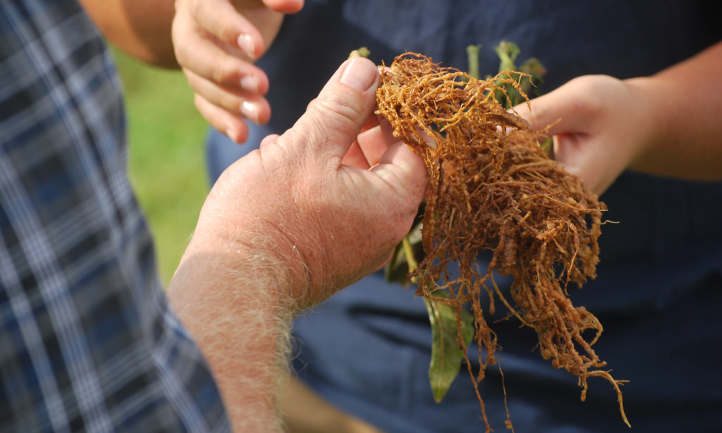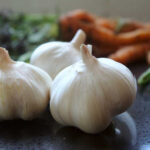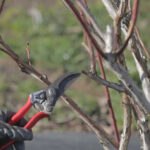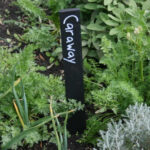We talk a lot about the root knot nematode, and that’s because this microscopic parasite can do a lot of damage to your plants. It’s not easy to determine if you’re battling against them, and yet your plant will suffer its effects.
So let’s discuss what these itty bitty parasites are, and what they actually do. We’ll go over methods to try to eliminate them from your yard, and talk about the differences between good nematodes and bad ones.
By the time we’re done, you should know the basics of how to deal with this particular batch of parasites to the best of your ability, and how to keep them away from your prized plants!
Subscribe to the Epic Gardening Podcast on
Root Knot Nematode Overview
| Common Name(s) | root knot nematode, northern root-knot nematode, southern root-knot nematode, cotton nematode, peanut nematode, British root-knot nematode, tea root-knot nematode, mature tea nematode, Indian nematode, coffee nematode, barley nematode, cereal root-knot nematode, African cotton root-knot nematode, African cotton root nematode, Thames’ root-knot nematode, northern root knot nematode, and other names |
| Scientific Name(s) | Meloidogyne spp. including Meloidogyne javanica, Meloidogyne arenaria, Meloidogyne incognita, Meloidogyne hapla, Meloidogyne enterolobii, Meloidogyne acronea, Meloidogyne artiellia, Meloidogyne brevicauda, Meloidogyne chitwoodi, Meloidogyne exigua, Meloidogyne fruglia, Meloidogyne gajuscus, Meloidogyne naasi, Meloidogyne partityla, Meloidogyne thamesi |
| Family | Meloidogynidae |
| Origin | Worldwide |
| Plants Affected | Alfalfa, African daisies, African violet, almond, apricot, avocado, azalea, banana, barley, bean, blackberry, butterfly flower, cantaloupe, carrot, capsicum, chickpea, cineraria, citrus, coffee, corn, cotton, cucumber, date palm, eggplant, grapes, hemp, hibiscus, hops, hydrangea, Jerusalem cherry, lentil, lettuce, lilac, nectarine, okra, olive, onion, papaya, pea, peach, peanut, pear, pecan, pepper, pigeonpea, pineapple, plantain, plum, potato, primula, pumpkin, raspberry, red clover, rose, soybean, squash, strawberry, sunflower, sweet potato, tea, tobacco, tomato, walnut, watermelon, many wild grasses/shrubs/trees/weeds. Thousands of species of plants may be impacted by root knot nematodes. |
| Common Remedies | Geraniol or quillaja saponaria compounds, azdirachtin, neem seed meal, crab meal, oyster shell flour, juglone (from black walnut leaves/hulls), soil solarization, addition of beneficial nematodes, planting of marigolds or sudangrass as cover crops. |
All About Root Knot Nematodes
From their name, it’s pretty easy to guess that these affect plant roots by invading root cells. But where do they come from, and what exactly are they?
What Are Nematodes?
A nematode is actually a form of roundworm. The category of roundworms is incredibly wide, covering at least 25,000 different root knot nematode species. Some of these species are beneficial to us, some are harmful.
From an agricultural perspective, there’s really two forms of nematode which are important to be aware of: predatory or parasitic.
Predatory nematodes are types which seek out and attack an assortment of other garden pests like cutworms or squash vine borers. I often refer to these as beneficial nematodes, as they help keep our gardens pest-free. These are great to have around!
Plant parasitic nematodes, on the other hand, are not so great. Often invisible to the naked eye, these will attack living plant matter and consume it. They can cause the plant to focus its attention on healing that damage rather than healthy growth.
Root knot nematodes, the Meloidogyne species, fall into the parasitic category. They can cause host plants to inexplicably yellow, develop stunted growth, or look weak. Their chewing on the root systems and root cells of affected plants can allow other plant diseases to take hold as well.
Root Knot Nematode Life Cycle
The life cycle of root knot nematodes can be quite complex, but it breaks down into a few phases. There is an embryonic stage, four juvenile stages, and an adult form.
An adult root knot nematode will create a gelatinous mass on the root system of a plant and lay its eggs into it. Up to a thousand eggs can be laid by one adult. During this embryonic stage, the nematode will go from embryo completely through the first juvenile phase.
Once the embryo has become a first-stage juvenile, it will begin to eat the egg it is encapsulated in. By the time it has consumed its egg and some of the gelatin around it to encounter soil, it has become a second stage juvenile.
This is when the root knot nematode problem begins to pose a danger to host plants. Second-stage juveniles will eat their way into the root. Their chewing and migration through the root causes root galls, which are bulbous masses that the plant forms while trying to heal its root system.
In time, the second stage juvenile will take up residence inside one of these galls. It will undergo its third and fourth juvenile stages inside the root knot or gall, moulting and developing until it emerges as an adult and begins the cycle anew.
Common Habitats Of Root Knot Nematodes
Soil-dwellers, root knot nematodes can be difficult to identify. After all, you usually cannot see them with the naked eye, and they aren’t above ground. In fact, they can often do so little damage to larger plants such as trees that they are not recognized as being there at all.
However, they do in fact attack thousands of plant species ranging from vegetable crops to trees, shrubs, and ornamental plants. There are estimated to be more than 90 different species, and while some are preferential to particular plant types, many are opportunistic.
They can be found around plant/tree roots in the soil, or inside the roots themselves. Depending on the phase of the life cycle, they may have caused the plant to create galls which they may inhabit.
What Do Root Knot Nematodes Eat?
It’s estimated that most nematode damage to food crops is done by the Meloidogyne species.
They only eat living plant material, and tend to only attack plant roots rather than to go after any above-ground plant matter. The range is very wide, comprising thousands upon thousands of plant species worldwide.
Four particular species of root knot nematode are at extremely high levels internationally and cause the majority of agricultural damage. Another seven species cause significant crop damage in their particular regions of the world, but have not reached global proportions.
The remainder of the root knot nematodes tend to feed mostly on the roots of grass, weeds, and wild plants or trees. These are still damaging to their targets, but are considered less significant as they do not directly attack human food supplies.
The following list is some (but not all) of the plants which can be impacted by root knot nematodes:
Alfalfa, African daisies, African violet, almond, apricot, avocado, azalea, banana, barley, bean, blackberry, butterfly flower, cantaloupe, carrot, capsicum, chickpea, cineraria, citrus, coffee, corn, cotton, cucumber, date palm, eggplant, grapes, hemp, hibiscus, hops, hydrangea, Jerusalem cherry, lentil, lettuce, lilac, nectarine, okra, olive, onion, papaya, pea, peach, peanut, pear, pecan, pepper, pigeonpea, pineapple, plantain, plum, potato, primula, pumpkin, raspberry, red clover, rose, soybean, squash, strawberry, sunflower, sweet potato, tea, tobacco, tomato, walnut, and watermelon.
There is a bright side to all of this. A number of nematode-resistant crops are available. Check your seed packets to see if the varieties you plan on planting are nematode-resistant, as these can hold up better to the damage which the tiny parasites inflict.
How To Get Rid Of Root Knot Nematodes
There are few organic solutions for a root knot nematode problem. Sure, there are nematicides available, but they’re usually only for commercial agriculture and aren’t widely available for home gardening use. So what can you do to eradicate these little parasites?
Organic Root Knot Nematode Control
Two organic nematicide variants are available: ones based on geraniol (the oil of geraniums) and ones based on quillaja saponaria, the soap bark root. Remember that nematicides kill off both the beneficial and plant parasitic nematodes.
You can also use an azadirachtin product. Azadirachtin is a naturally-occuring pesticide extracted from neem oil. This may work as a light nematicide, but tends to be better against other pests such as spider mites, thrips, aphids, and more.
Add neem seed meal, crab meal, or oyster shell flour to your soil. All three are fertilizers, but they’re great soil builders in the war against root knot nematodes.
Neem seed meal is a gentle fertilizer which is made from the leftover material after making neem oil. It helps reduce a number of pests naturally, plus it breaks down to add low levels of nitrogen to the soil. It also can help strengthen the roots of plants to make them resistant.
Crab meal encourages beneficial soil microorganisms which reduce nematode population. It also helps plants to increase the strength of their cell walls, making them more naturally resistant to many conditions.
Oyster shell flour is, in essence, a form of diatomaceous earth. While it has less effect when it’s wet, it can help make the soil less hospitable to nematode populations and reduce other pests as well.
Black walnut leaves and hulls have a natural compound in them which is called juglone. This compound is an extremely effective killer of root knot nematodes but can have an adverse effect on some plants. That’s why there’s few weeds around walnut trees!
If you want to put an organic source of juglone to work in your garden, use fresh walnut leaves or smashed hulls as a thick layer of compost on your bed, or just build a tall pile there. Regularly turn it to keep it composting. I use leaves, as they’re quick to break down.
The juglone compounds will seep into the soil when you wet down the pile, and after three to six months should have broken down enough that they will no longer be toxic to other plants. This also helps wipe out weeds or other pests that may be in your beds during composting.
Environmental Root Knot Nematode Control
Soil solarization is a common environmental method of wiping out root-knot nematodes and some species of fungi. However, soil solarization will kill all beneficial nematodes, fungi, or bacteria which are in your beds as well, so this is an option which you should not take lightly.
To solarize your soil, till the soil and flatten it out. Dampen the soil evenly, and then place a thick sheet of clear plastic overtop the soil surface, securing it tightly down so it doesn’t move. Leave the plastic on top of the soil during the hottest months of the year for at least 2-3 months.
After you’ve solarized your soil, it’s important to add back in beneficial mycorrhizal fungi, bacteria, and nematodes. These will help prevent future pest and disease outbreaks. You can use a mycorrhizal product to replenish the fungal and bacterial growth.
For beneficial nematodes, I recommend applying a mix of Sf, Sc, and Hb species, three different forms that will kill off a wide variety of pests. The Steinernema feltiae species is especially vital for pest control, including root knot nematodes.
Marigolds release a natural compound into the soil which is toxic to root knot nematodes. If you plant marigolds as a cover crop between plantings of food crops, you may see a slow and gradual reduction in activity. This works cumulatively in the soil.
Growing marigolds as a cover crop means you will need to till them back into the soil at the end of their growing season. However, this adds more plant matter to the soil, which improves the soil over time. In addition, marigolds are a great companion plant for tomatoes!
Another plant which produces a similar natural compound as a cover crop is sudangrass. Related to sorghum, this grass can reach heights of up to 7 feet tall, so it will need to be mowed regularly to keep it in check.
Leave the grass clippings to break down into the soil, as it will release its nematode protection as it decays. It also adds valuable nitrogen back into the soil. If you’re growing in raised beds, you can use grass shears to keep it trimmed down, and till it under at the end of the season.
Preventing Root Knot Nematodes
Prevention is always the best cure for a pest problem, and root knot nematodes are no exception. So let’s talk about prevention.
First off, plant nematode-resistant varieties. There are a wide variety of different seed suppliers who carry nematode-resistant seed stock, usually notated as an N in the resistance charts.
If you cannot plant nematode-resistant strains, practice good crop rotation. Some species of root knot nematodes are more selective than others. Planting cover crops like marigolds or sudangrass between at-risk crops will also bring down the nematode population.
Remove the root tissue of affected plants when clearing the bed. As juveniles can live in the galls they form on the roots, they will continue to multiply even as the roots are dying out. Removing the remaining root mass can extract those juveniles.
Till the soil 2-3 times in the fall. This breaks up the soil, turning the nematodes up to the surface where they will die off from exposure to the sunlight. This will impact both beneficial and plant parasitic nematodes, so you may need to re-add beneficial nematodes again in the spring.
Plant overwintering grass cover crops like wheatgrass, ryegrass, or rye. Sudangrass is also good and offers some nematicide properties. Keep these mowed down to a manageable level, and till them under in the spring to add more plant matter to the soil.
Regularly add more organic material to your soil. Adding more composted leaves, grass clippings, and manure to your beds will help naturally control the population of nematodes in the soil, since nematodes prefer living material to decaying plant matter.
Frequently Asked Questions
Q: What are the symptoms of root knot nematodes in plants?
A: That’s difficult to determine, because a very healthy, vigorous plant may show no symptoms at all!
As a general rule, common symptoms of a bad nematode infestation can include chlorosis (yellowing of the leaves/stems), stunted growth, wilting, and a lack of production of fruit.
However, these may be nonexistent to severe depending on the population of nematodes, the health of the plant, the natural resistance of the plant, and any number of other factors in the soil makeup. It can also be hard to separate the symptoms from other pest/disease issues.
The only real way to be sure that it is in fact root knot nematodes is to carefully remove a plant from the soil and examine its roots. If there are a lot of galls growing along the root system, it’s likely root knot nematodes at work.









